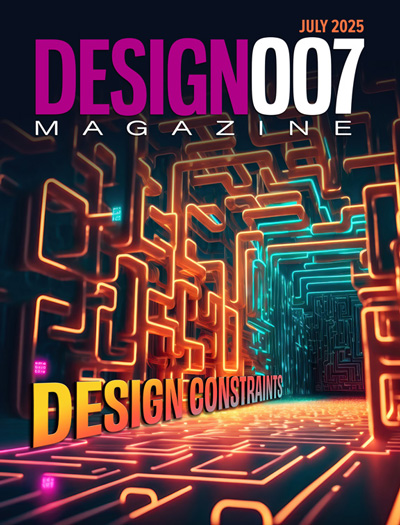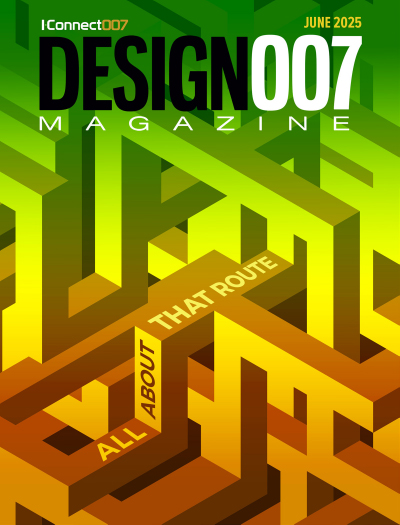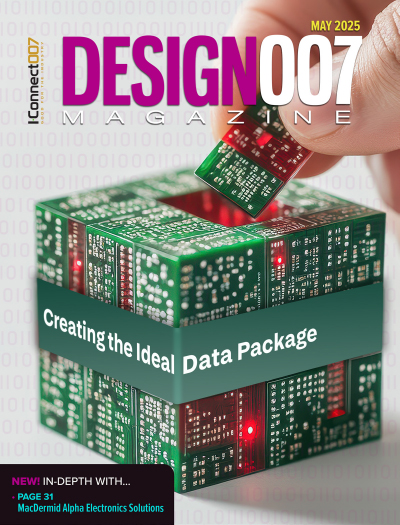-

- News
- Books
Featured Books
- design007 Magazine
Latest Issues
Current Issue
Showing Some Constraint
A strong design constraint strategy carefully balances a wide range of electrical and manufacturing trade-offs. This month, we explore the key requirements, common challenges, and best practices behind building an effective constraint strategy.

All About That Route
Most designers favor manual routing, but today's interactive autorouters may be changing designers' minds by allowing users more direct control. In this issue, our expert contributors discuss a variety of manual and autorouting strategies.

Creating the Ideal Data Package
Why is it so difficult to create the ideal data package? Many of these simple errors can be alleviated by paying attention to detail—and knowing what issues to look out for. So, this month, our experts weigh in on the best practices for creating the ideal design data package for your design.
- Articles
- Columns
- Links
- Media kit
||| MENU - design007 Magazine
Recruiting the Next Generation of PCB Designers at Garmin
March 6, 2025 | Andy Shaughnessy, I-Connect007Estimated reading time: 2 minutes
Laura Beth (LB) Yates, PCB design engineering manager at Garmin, discusses the company's innovative approach to recruiting the next generation of PCB designers. LB is leading the company’s efforts to find and develop new talent, which includes working with technical schools, and inspiring high school students to pursue careers in PCB design.
In this interview, she discusses Garmin’s plans to create a robust pipeline of skilled professionals ready to become the next generation of PCB designers. As she points out, the best part of her job is “going to work every day with my friends and making cool stuff.” If you’re looking for a job making cool stuff, LB would love to speak with you.
Andy Shaughnessy: LB, I understand that you have a plan for recruiting PCB designers. Walk me through your process.
Laura Beth (LB) Yates: We have PCB design teams in Cary, North Carolina; Olathe, Kansas, where Garmin is headquartered; Salem, Oregon; and Cochran, Alberta, Canada. We partner with local tech schools and our vendor, EMA Design Automation, gives them licenses and curricula to help train PCB designers as part of their electronics programs.
EMA Design Automation has developed a curriculum to take the Arduino module from schematic to PCB layout/DFM. EMA will give that curriculum and OrCAD licenses to the schools to help them implement this, and then we have a pipeline to hire designers who are new to the industry.
Shaughnessy: Does Garmin teach this class?
Yates: We don’t; the tech schools are teaching these classes. They already have electronic technician programs. If you already have a program, this is just a semester or a module of that program. Then we can hire from that program.
Shaughnessy: That's great. Design instruction is much needed right now.
Yates: I agree, and we have tech school partners in most locations of our PCB Design teams.
Shaughnessy: How do you get students into these programs in the first place?
Yates: Garmin has recruiting events where we talk to high school juniors and seniors to get them jazzed about non-traditional careers in tech, whether that's troubleshooting for customers and doing customer support on one of our many products, PCB design, or engineering technician bench work. There are different jobs available, so when I talk to these high schoolers, I ask, “Do you like sitting in a dark room and rocking out to music and playing puzzle-solving video games? Because that's a job, and it's called PCB design.”
To read this entire conversation, which appeared in the February 2025 issue of Design007 Magazine, click here.
Testimonial
"Advertising in PCB007 Magazine has been a great way to showcase our bare board testers to the right audience. The I-Connect007 team makes the process smooth and professional. We’re proud to be featured in such a trusted publication."
Klaus Koziol - atgSuggested Items
Direct Metallization: A Sustainable Shift in PCB Fabrication
07/31/2025 | Jim Watkowski, Harry Yang, and Mark Edwards, MacDermid Alpha Electronic SolutionsThe global electronics industry is undergoing a significant transformation, driven by the need for more resilient supply chains and environmentally sustainable manufacturing practices. Printed circuit boards (PCBs), the backbone of interconnection for electronic devices, are at the center of this shift. Traditionally, PCB fabrication has relied heavily on electroless copper, a process that, while effective, is resource-intensive and environmentally hazardous. In response, many manufacturers are turning to direct metallization technologies as a cleaner, more efficient alternative.
MacDermid Alpha Electronics Solutions Unveils Unified Global Website to Deepen Customer, Talent, and Stakeholder Engagement
07/31/2025 | MacDermid Alpha Electronics SolutionsMacDermid Alpha Electronics Solutions, the electronics business of Elements Solutions Inc, today launched macdermidalpha.com - a unified global website built to deepen digital engagement. The launch marks a significant milestone in the business’ ongoing commitment to delivering more meaningful, interactive, and impactful experiences for its customers, talent, and stakeholders worldwide.
Considering the Future of Impending Copper Tariffs
07/30/2025 | I-Connect007 Editorial TeamThe Global Electronics Association is alerting industry members that a potential 50% tariff on copper could hit U.S. electronics manufacturers where it hurts.
Reciprocal Tariffs and Talent Bottlenecks are Driving Changes in PCB Investment in Southeast Asia
07/30/2025 | TPCAAs the global supply chain continues to restructure, Southeast Asia, leveraging its geographical advantages and favorable policies, has become a strategic hub for global circuit board manufacturing.
Target Condition: The 5 Ws of PCB Design Constraints
07/29/2025 | Kelly Dack -- Column: Target ConditionHave you ever sat down to define PCB design constraints and found yourself staring at a settings window with more checkboxes than a tax form? You’re not alone. For many designers—especially those newer to the layout world—the task of setting up design constraints can feel like trying to write a novel in a language you just started learning.


